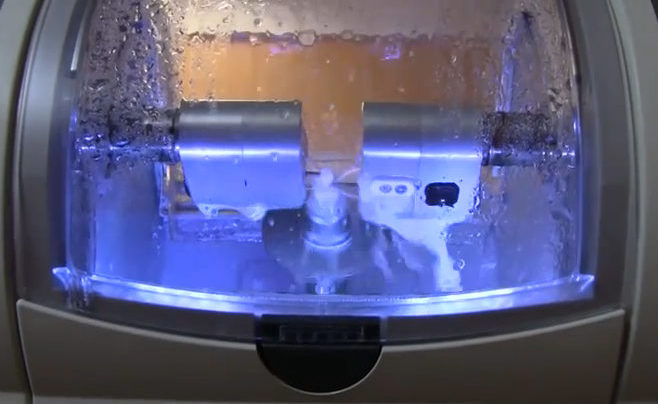Diamond Certified Experts: Innovations in Dental Technology

As in other professional fields, technological innovation is changing the landscape of the dental industry. Photo: William M. Schneider D.D.S. (2017)
In our scientifically advanced age, technology is altering the landscapes of many professional fields. The dental field is no exception, with innovation yielding improved methods and products for treating age-old problems. To learn more, we’ve asked six Diamond Certified Expert Contributors to expound on some of these innovations in dental technology.
Innovations in Dental Prosthetics
Throughout history, people have supplemented lost or missing teeth using whatever methods were available to them at the time. For example, President George Washington wore multiple sets of false teeth, each composed of materials ranging from ivory to gold (not wood, as myth would have it). Fortunately, dental prosthetics have since become more sophisticated, culminating in the modern innovation known as dental implants.
Dr. Alfred dela Cruz explains how dental implants improve upon earlier prosthetics like bridges. “Unlike a bridge, which requires support from adjacent teeth to function, an implant is actually drilled into the jawbone as a free-standing tooth. Once the bone has grown into the implant, a post is placed onto the tooth and a crown is installed. Not only does this create the visual appearance of a genuine tooth, it also greatly simplifies oral hygiene tasks like flossing, which can be difficult with a bridge.”
Besides making dental prosthetics more practical and visually attractive, technological innovation has simplified the process of designing and manufacturing them. Dr. Lovely Manlapaz elaborates: “In the past, if you needed a crown or similar prosthetic, your dentist would have you bite down on a tray filled with a gooey substance to create an impression of your teeth, which would then be used to design your prosthetic. Fortunately, this unsavory process has since been replaced by computer-aided design and manufacturing, or CADCAM, which allows dentists to take digital impressions of teeth using computer imaging. After being digitally designed, your new crown can be manufactured in minutes with an in-office milling machine and subsequently installed. It used to take two weeks to get a crown or implant installed, but now you can get it the same day you’re fitted.”
Innovations in Cavity Detection and Treatment
Preventative cavity detection has long been performed via x-rays, but in recent years, many dentists have adopted a new and improved technique: laser technology. “When shined on the chewing surfaces of teeth, lasers can measure the reflected light energy, or ‘fluorescence,’ of the tooth structures’ various layers,” explains Dr. James Mattingly. A key benefit of laser technology is its ability to detect cavities early, while they’re still in their developing stages. This gives patients an opportunity to have cavities removed before they grow bigger and cause more damage to the teeth.
In addition to new methods for cavity detection, technological innovation is yielding new methods for cavity treatment. For example, Dr. John Licking says ozone gas enables him to heal, rather than replace, his patients’ decayed teeth. “While it has only lately been applied to dentistry, ozone therapy has long been used in the medical field to treat everything from heart disease to macular degeneration. Ozone gas is effective because even though it’s deadly to bacteria, viruses and fungi, healthy cells remain unaffected by it when applied at low concentrations. When used to treat tooth decay, ozone gas provides an additional benefit: it begins a process of repair, wherein the decayed areas of the teeth are re-mineralized and turned back into solid, structurally sound material. This minimizes the need for fillings or prosthetics.”
Innovations in Dental Applications for Sleep Disorders
In some cases, the application of dental technology extends beyond the teeth and gums. For example, some dentists are using it to treat sleep apnea, a serious disorder that causes a person to stop breathing at random intervals during sleep. “Often, minor cases of sleep apnea can be treated using an oral appliance,” affirms Dr. William Schneider. “Worn in the mouth during sleep, this appliance brings the jaw forward to open up the airway, which makes it easier for the wearer to breathe. When effective, this option is much simpler than other treatments like using a CPAP machine or having corrective surgery.”
According to Dr. Josh Hammer, this isn’t the only instance where a dental appliance can help with sleep problems. “One common way people exhibit stress is through clenching and grinding their teeth during sleep, which can result in tooth and jaw pain,” he explains. “Fortunately, there’s a simple tool that can alleviate this: a night guard. When worn in the mouth during sleep, this device protects the surfaces of your teeth from grinding. Additionally, the cushion it provides helps allay jaw strain caused by clenching.” For optimal results, Dr. Hammer recommends having a night guard custom-designed by your dentist; however, he says even a generic, store-bought one is better than nothing.
Use Diamond Certified Resource to find top rated companies.
Local, Top Rated Diamond Certified Practices Related to Your Topic
Contra Costa County Dentists
Alameda County Dentists
Related Articles
The Essential Guide to Dentists
Get Expert Advice From Owners of Top Rated Local Companies
Become a Diamond Certified Preferred Member (Always Free)